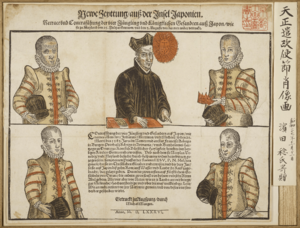Itō Mancio facts for kids
Quick facts for kids
Itō Mancio
|
|
|---|---|
| 伊東 マンショ | |

Itō Mancio, by Italian painter Domenico Tintoretto (1585)
|
|
| Born |
Itō Sukemasu
January 1, 1569 Hyūga Province, Tonokōri, Japan
|
| Died | November 13, 1612 (aged 43) Nagasaki, Japan
|
| Nationality | Japanese |
| Occupation |
|
| Years active | 1582–1612 |
| Parents |
|
| Family | Itō clan, Itō Yoshisuke (grandfather) |
Itō Mancio (born around 1569 – died November 13, 1612) was a Japanese Jesuit and a Catholic priest. He was chosen to lead the Tenshō embassy, which was the very first Japanese group to visit Europe.
Early Life
Itō Mancio was born in 1569 in a place called Tonokōri in Hyūga Province, Japan. This area is now known as Saito, Miyazaki. He came from an important family called the Itō clan. His birth name was Itō Sukemasu. His father was Itō Sukeharu, and his mother, Machinoue, was the daughter of a powerful Japanese lord, or daimyo, named Itō Yoshisuke.
The Journey to Europe
Itō Mancio studied important subjects like theology (the study of religious faith) and Latin (an old language) at a special school in Nagasaki.
He became the leader of the Tenshō embassy, a special group that traveled to Europe from 1582 to 1590. The idea for this trip came from a Jesuit named Alessandro Valignano. It was supported by three Christian daimyo: Ōtomo Sōrin, Ōmura Sumitada, and Arima Harunobu. Itō Mancio was chosen by Ōtomo Sōrin, who was a relative of Mancio's father.
In 1580, Itō Mancio was baptized and given the Christian name Mancio. On February 20, 1582, he left Nagasaki with three other young nobles: Michele Chijiwa, Giuliano Nakaura, and Martino Hara. They also had two servants and their teacher, Diego de Mesquita.
Their long journey took them through many places. They stopped in Macau, Kochi, and Goa in India. From there, they sailed to Lisbon, Portugal. Their main goal was to reach Rome, Italy.
In Rome, Itō Mancio was given a special honor. He was made an "honorary citizen" and received a fancy award called the Order of the Golden Spur. On their way back from Rome, they visited Venice and even stopped in a town called Imola for a day. A special document was written there to remember their visit.
The ambassadors finally returned to Japan on July 21, 1590. During their time in Europe, they met important leaders like King Philip II of Spain, the Grand Duke of Tuscany Francesco I de 'Medici, Pope Gregory XIII, and the next Pope, Pope Sixtus V.
Later Life
In 1608, Itō Mancio officially joined the order of Jesuit priests. He worked as a missionary, sharing his faith in different parts of northwest Japan. However, he was later asked to leave the Kokura domain and then moved to the Nakatsu Domain.
Eventually, he was sent to Nagasaki, where he became a teacher at a seminary, a school for training priests. Itō Mancio passed away in Nagasaki in 1612, at the age of 43, after falling ill.
His Portrait
In 2008, a painting of Itō Mancio was found. Experts confirmed it was real and believed it was painted by Domenico Tintoretto, a famous Italian artist. The painting is an oil on canvas and shows a young man from Asia wearing Spanish clothes from the late 1500s. He has a brown suit, a black hat, and a white ruff around his neck.
The city of Venice asked Jacopo Tintoretto to paint this portrait in 1585 when the ambassadors visited the city. However, it was actually his son, Domenico, who painted it. The painting was later owned by different people and families over the centuries.
In 2009, the painting was cleaned and repaired. It was then shown in Tokyo, Nagasaki, and Miyazaki (Mancio's hometown). This happened in 2016 to celebrate 150 years of diplomatic relations between Italy and Japan.
See also
 In Spanish: Mancio Ito para niños
In Spanish: Mancio Ito para niños
- Hasekura Tsunenaga
- Christianity in Japan



